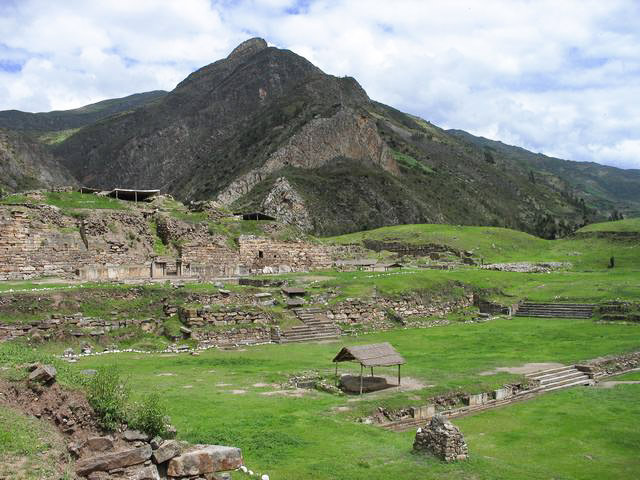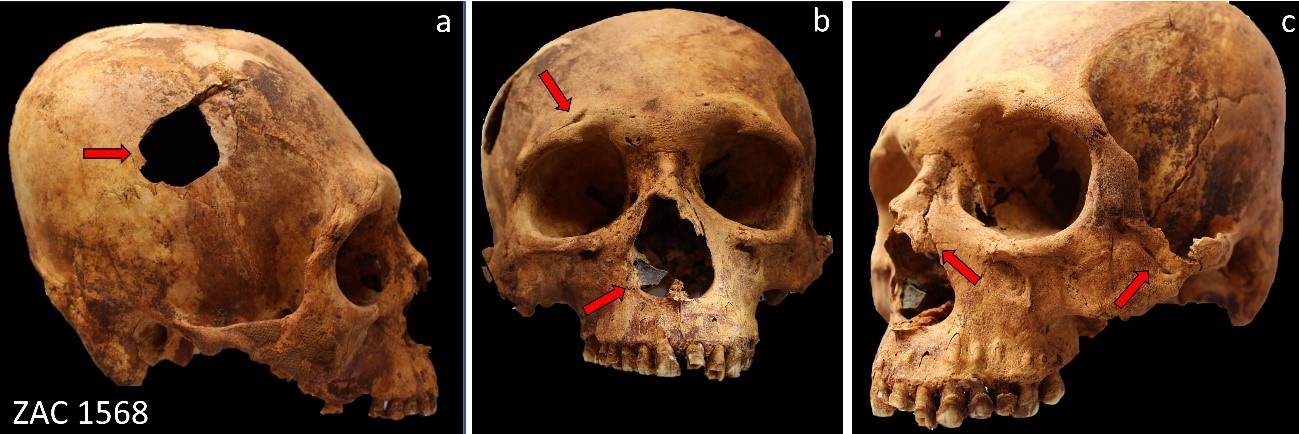

Detail of the Chavín de Huantar archeological site in Peru’s northern mountains. The period of violence investigated in the study may have seen the fall of the Chavín culture and a shift from theocracy to secular government (photo: Sharon odb/Wikimedia Commons)
Analysis of skeletons exhumed at a burial ground dating from the period 500-400 BCE, shortly after the collapse of the Chavín culture, revealed lethal injuries inflicted on men, women and children, as well as signs of material poverty.
Analysis of skeletons exhumed at a burial ground dating from the period 500-400 BCE, shortly after the collapse of the Chavín culture, revealed lethal injuries inflicted on men, women and children, as well as signs of material poverty.

Detail of the Chavín de Huantar archeological site in Peru’s northern mountains. The period of violence investigated in the study may have seen the fall of the Chavín culture and a shift from theocracy to secular government (photo: Sharon odb/Wikimedia Commons)
By José Tadeu Arantes | Agência FAPESP – The transition from the fifth to the fourth century BCE (Before the Common Era) seems to have been a critical period for the Central Andes, a region now part of Peru. Researchers have found evidence of turbulence during the passage from the Middle Formative period (1200-400 BCE) to the Late Formative period (400-1 BCE). Political disintegration and intergroup violence were apparently part of the context, possibly associated with a shift from theocracy to secular government. A new study, published in the journal Latin American Antiquity, consistently reinforces these suppositions.
The study was conducted by a team of Peruvian, Colombian and Brazilian researchers led by Peruvian bioarcheologist Luis Pezo-Lanfranco, then affiliated with the Biological Anthropology Laboratory at the University of São Paulo’s Institute of Biosciences (IB-USP) in Brazil. The project was supported by FAPESP via the Grant Program for Young Investigators in Emerging Research Centers.
“We made a detailed analysis of the skeletal remains of 67 individuals excavated at a burial ground dating from the period 500-400 BCE and located in the Supe Valley region, a few kilometers from Caral, a famous ceremonial center that functioned between 2900 and 1800 BCE. There we detected injury patterns characteristic of repeated events of interpersonal violence. Among the individuals examined, 80% of the adults and adolescents died from inflicted traumatic injuries,” Pezo-Lanfranco told Agência FAPESP. He currently works in the Department of Prehistory at the Autonomous University of Barcelona (UAB) in Spain.
Perimortem injuries to the skull, face and chest observed in several individuals are compatible with lethal, probably intercommunity, violence, whose victims included children. “Our hypothesis is that a group of strangers came to the community and committed the murders. After the aggressors left, the murder victims were buried by their own people with the usual funeral rites, as suggested by the burial patterns,” he said.
Perimortem means at or near the time of death. Bone damage in perimortem injuries shows no evidence of healing. Bone damage in antemortem injuries shows evidence of healing.
Although perimortem trauma was the most frequent type of injury among the adult skeletons studied, as well as some of the child remains, many examples of antemortem trauma were also found, and several individuals displayed both, suggesting the occurrence of at least two violent events during their lives. The first led to injuries that healed, while the second killed them.
“The markers point to exposure to repetitive and lethal violence during the course of their lives,” Pezo-Lanfranco said. The most frequent injuries were depressed fractures of the cranial vault, other maxillofacial fractures, thoracic fractures (mainly in ribs and scapulae), and “defensive” fractures of the ulna (forearm, indicating an attempt to parry a blow).

Various traumatic injuries in one of the individuals studied: a) perimortem penetrating fracture in right parietal produced by blunt force trauma; b) cut mark in right superciliary arch relating to sharp force trauma, and perimortem injury relating to stone flake, which remains embedded in right wall of nasal pyriform aperture; c) healed linear penetrating fracture and cut marks in left zygomatic bone relating to sharp-blunt force trauma, and healed nasal fracture (photos: Luis Pezo-Lanfranco)
Sixty-four of the 67 individuals studied were buried in a fetal position: 12 in dorsal decubitus (lying on their back), four in ventral decubitus (on their stomach), seven in left lateral decubitus (on their left side), and 41 in right lateral decubitus. The fetal position is a recurring burial pattern in prehistoric and ancient communities worldwide. Given its association with the womb, some experts believe it reflects the expectation of rebirth after death.
Besides the signs of violence, the analysis of the bones showed a high incidence of non-specific stresses and infectious diseases, possibly associated with adverse living conditions due to a combination of a shortage of resources and population growth. The simplicity of most of the grave goods also points to poverty. Many of the skeletons were buried with plain cotton fabric, woven mats and basketry, gourds containing vegetables, cotton seeds and roots, necklaces, and pottery. “Stable isotope studies showed that staple crops were the basis for their subsistence,” Pezo-Lanfranco said.
Competition for scant resources in the Supe Valley region was probably a major factor in the collapse of the Chavín culture, which spread through Peru’s mountains and coast between 1200 and 500 BCE. Its center was Chavín de Huantar, a monumental ceremonial site in northern Peru in the Marañon River basin. The Marañón rises in the Peruvian Andes at about 5,800 m, first flowing northwest and then turning northeast to meet the Ucayali and become the Upper Amazon and Solimões in Brazil.
“The Chavín system reached exhaustion during the Middle to Late Formative transition, around 500-400 BCE. Several ceremonial centers, including Chavín de Huantar, were desacralized and abandoned. Political formations organized around the religious sphere disintegrated, perhaps characterizing the decline of theocracy and the emergence of secular government,” Pezo-Lanfranco said.
The Chavín people worshipped a “zooanthropomorphic” deity resembling a man-jaguar. Gods that combine animal and human attributes are featured in many ancient cultures around the world, including those of Crete, India and Egypt. In a purely speculative approach, some scholars think they may be later re-elaborations of prehistoric shamanic traditions in which the virtues of tutelary animals are syncretized in the figure of the shaman. This hypothesis cannot be confirmed on the basis of existing knowledge.
The name of the Chavín man-jaguar god is unknown. Unlike ancient civilizations in the Old World, the Andean people who worshiped the deity left no written records that could be deciphered to furnish more detailed information. It is worth stressing that the period in question preceded the formal establishment of the Inca Empire by almost 2,000 years. Founded by Pachacuti in 1438 CE (Common Era), the Inca Empire was the ultimate expression of thousands of years of Andean civilizations, yet it lasted for less than 100 years. The Spanish executed the last reigning Inca Emperor, Atahualpa, in 1533, and in 1572 captured and killed Túpac Amaru in Vilcabamba, where he had been leading the resistance.
For the researchers who conducted the study, the results are particularly important because of what they reveal about an era of ancient Andean history that has so far been poorly documented. Few burial grounds from the period in the Central Andes have been excavated, and still fewer have been found to contain remains as well-conserved as these. Their conservation is due mainly to the dry climate in the region, permitting detailed observation of injuries in almost intact bones.
“The study belongs to a field we call the ‘bioarcheology of violence”, which helps understand the nature of interpersonal conflict around the middle of the first millennium before the common era. On the other hand, data from the same analysis, to be published soon, offers several answers regarding factors in this society that modulated morbidity and mortality, which developed in the hypothetical context of population pressure and political transition associated with the collapse of belief systems in a highly resource-poor environment,” Pezo-Lanfranco said.
The article “Bioarchaeological evidence of violence between the Middle and Late Formative (500-400 BC) in the Peruvian north-central coast” is at: www.cambridge.org/core/journals/latin-american-antiquity/article/abs/bioarchaeological-evidence-of-violence-between-the-middle-and-late-formative-500400-bc-in-the-peruvian-northcentral-coast/A32D6097D29F59E83DB562EC80189D66.
Republish
The Agency FAPESP licenses news via Creative Commons (CC-BY-NC-ND) so that they can be republished free of charge and in a simple way by other digital or printed vehicles. Agência FAPESP must be credited as the source of the content being republished and the name of the reporter (if any) must be attributed. Using the HMTL button below allows compliance with these rules, detailed in Digital Republishing Policy FAPESP.





